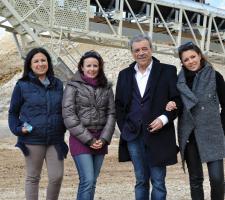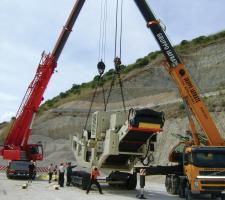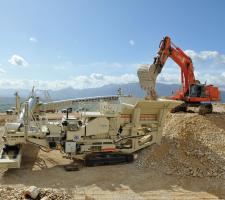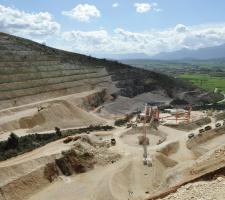
As up to one million people gather in Rome for Pope Francis’ inauguration mass we head out of the city. The move is not to avoid the crowds, but to drive to a quarry near Anagni, a small and historic medieval town on the ridge of a hill some 475m above sea level and 72km east of the Italian capital.
The quarry has invested in a new crushing system, and has drastically reduced truck movements. Patrick Smith reports
Built inside powerful Roman boundary walls, Anagni has small twisting streets and steep lanes everywhere, similar topography to that found in the nearby family-owned Della Marocca Costruzioni Group quarry, which produces a sought-after limestone product with a very high purity and brightness.
The quarry, which produces 21 different grades of aggregates, sees its truck fleet deliver products across central Italy, including the cities of Florence and Naples, for use in road construction, cement, asphalt, plaster and in public works. It also produces sand. The calcareous aggregate is utilised also as tout-venant for the construction of roadbeds.
At the quarry, which Marocca has operated since 1954, extremely steep and winding haul roads still exist and these demanding routes were used until recently by a variety of dump trucks to move material from the quarry’s upper slopes (it is some 495m above sea level) to the fixed crushing station some 140m below.
Recently the topsoil was removed on a new site on the hillside, and an
The quarry has not had any problems with its blasting because it is comparatively isolated but efforts are made to keep noise to a minimum.
The crushing plant houses a number of crushing options, including a
At present trucks still move material from stockpiles at the base of the hill to the crushing area.
But in the last few years the entire Marocca quarry has undergone a major revamp. And in future it is likely that the crushing station is also further upgraded as part of the multi-million euro upgrade.
The haul roads, used now by service vehicles, used to put a tremendous strain on the dump trucks, and in particular their tyres and engines, and this led in turn to a rapid increase in maintenance costs.
The answer, while not inexpensive, was simple: put a mobile crusher near the top of the new site on the hill and incorporate a flexible conveyor system along with some 800m of conveyor belt to carry crushed limestone for further processing down the steep inclines to the point near the bottom. This was installed by an Italian contractor.
The new equipment includes a
The Metso conveyor system is the first of its type in Italy, and all the equipment was supplied by Metso’s Italian dealer SCAI following discussions between Marocca and Carlo Rinolfi, who is responsible for products with SCAI.
Eric Bonin, Metso’s Southern Europe dealer business manager, Mining and Construction Technology, was also involved.
“We were on top of the hill and the new access road was not designed. I thought there was no way to get the Lokotrack up there but we did it. The road at the top of the hill has also been made wider,” says Carlo Rinolfi.
“Moving the crushing up to the top of the quarry was complicated.”
At present, where the whole conveyor system ends the material is dumped over the side of a 20m high wall and is gathered in stockpiles.
A few metres away a new concrete tunnel is also fitted with a conveyor system that will eventually be connected to the new belt system and carry the material to the crushing area. A mix of trucks from
“The idea is to have the material being put down a “chimney” to meet the tunnel conveyor belt and from there it will be taken for further crushing,” says the head of the Marocca Construzioni group, Alberto Marocca.
The director general is assisted in the enterprise by his daughter Elena and his grandchildren Giovanna and Roberta.
A qualified architect, Marocca has worked at the Anagni quarry for over 40 years and he is hoping that the business will remain in the family when he retires.
The Marocca Group, one of the oldest family-run companies in the sector in Italy, was founded in 1900 by Francesco Marocca who was later followed into the business by his son Adolfo who in 1921 was responsible for introducing the production of asphalt into to the business.
Marocca now owns a number of asphalt and concrete plants, including the biggest asphalt plant in the region, a 220tonnes/hour Marini plant, which is capable of recyling materials.
In the 1970s the business continued, with Adolfo’s sons Alberto and Gianfranco focusing on industrialisation and automation of manufacturing processes and construction activities.
While Marocca has also been affected by the financial problems, one bonus is that the company owns the 43 hectare quarry site of which 32 hecatres is currently being used.
“We have some 25 million m³ of material left here or some 50 years of reserves. But it depends on the market.
If the market continues as it is it might be 100 years of reserves,” says Marocca, who employs 50 people at Anagni (75 at maximum production).
A problem the group faced was Italian regulations regarding quarries, and the new set up, which marks a significant change in quarry operations, has helped with these.
Previous benching at the quarry produced a 45º angle and legislation meant this had to be reduced to 30º.
The new plant configuration at the top of the quarry means the top downwards extraction approach, working in horizontal phases, produces shallower benches in the final profile.
A new bench height of some 2m with a depth of 4m will achieve the required new angle, while Marocca’s investment simplifies extraction; reduces the number of people required, and is seen to be safer.
“The principle benefit of this new system is that you lose the dumper. The cost of maintenance is not as expensive as before,” says Marocca.
Indeed, the group spends a lot of time and money on machine maintenance and efforts to improve operator skills; safety and restoration, with trees already being planted on worked out benches.
The Lokotrack crusher was received in the quarry in September, 2012, and work on installing the Lokotrack and Lokolink started in November, 2012, and took two months to complete. Further work was scheduled to be completed by June.
“We used a special Lokolink simulator to teach the operators how to use the machine during a week-long course,” says Carlo Rinolfi.
The LT140 has a maximum capacity of 1,200tonnes/hour and its product size is 300mm, but at present the crusher is set to average around 800tonnes/hour or some 120,000tonnes/month to cater for the capacity of the downhill conveyor system, which can handle up to 850tonnes/hour.
If too much loaded material is loaded onto the conveyor it is likely to overheat.
The Hitachi EX1200 excavator, which has a 7m³ bucket and can take 10tonnes of material, usually loads the crusher every 40 seconds, but at present it is working with a reduced bucket fill.
“The original Lokotrack was introduced in 1985 and Lokolink in 1992,” says Eric Bonin.
“The new LT140 is a big primary crusher for when you are looking for high power and high quality. I think the customer was surprised by the throughput.”
According to Metso, to date almost 100 Lokotrack and Lokolink systems have been delivered worldwide, and the biggest Lokotrack LT200 primary jaw crusher, mobile apron feeder and mobile conveyor system, is being built for the Altay Polimetally open pit copper mine in Kazakhstan. It is a 2,500tonnes/hour operation. “The main benefits of the crushing and conveying system is eliminating the moving of materials by dump trucks; less exhaust emissions; less dust and noise; a safer operating environment and better cost effectiveness,” says Eric Bonin.
The quarry was also the first in Europe to use the 11tonne HP 18000 hydraulic breaker from Italian company
Quality is high on Marocca Costruzioni’s agenda, and for aggregates it has obtained a Certificate of Factory Production Control.
The quality orientation involves, in a process of improvement, the entire organisation of Marocca Costruzioni in order to improve the efficiency and efficacy in relation to the customer.
“The main object, and the core value, is the customer satisfaction (both the external and internal customers to Marocca Costruzioni),” says Marocca.
Indeed, Marocca Costruzioni has established its own system of quality management as a strategic tool and this includes a guarantee to its customers that its products and services are able to meet their needs and are in compliance with applicable laws and produce the maximum benefit, and to try to act quickly on the causes of potential problems rather than intervening after the effects were detected.
“The Quality Manual (QM) is applied to all Marocca Costruzioni activities that affect, directly or indirectly, the quality of the activities carried out by the company, in particular to processes regarding the construction of roads, aqueduct works and evacuation works, mining and processing of limestone aggregates.”
DRILLING
1 x Atlas Copco
ROC F6 drill
BREAKERS
1 x Indeco 18000
1 x Indeco 12000
1 x Indeco 7000
1 x Indeco 2500
WHEELED LOADERS
1 x Caterpillar 980G
2 x Caterpillar 966G
1 x Caterpillar 428C
CRAWLER EXCAVATORS
1 x Hitachi EX1200 Super
1 x Hitachi 670 LCH-3
1 x Hitachi ZX 210 LCN-3
1 x Caterpillar 365 BL
1 x Caterpillar 345 CL
1 x Caterpillar 330 CLN
1 x Caterpillar 317 B
1 x Yanmar B17
TRACKED LOADERS
1 x Caterpillar 973CB
1 x Caterpillar 955L
RIGID DUMP TRUCKS
1 x Perlini DP405
1 x Perlini DP205
1 x Perlini T15
ARTICULATED DUMP TRUCKS
1 x Bell B25D
MOBILE CRUSHERS
1 x Metso
Lokotrack primary jaw crusher and Lokolink LL12
mobile conveyor
1 x REV GRC 98
FIXED CRUSHERS
1 x Hazemag
AP-PH1214
1 x MEM 1150
2 x MEM R5
1 x L&P CR 61
1 x Morandotti P4













